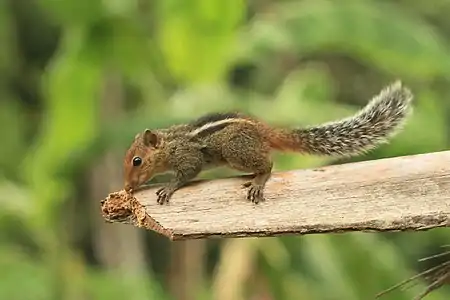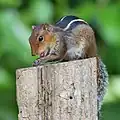| Jungle palm squirrel[1] | |
|---|---|
 | |
| Scientific classification | |
| Domain: | Eukaryota |
| Kingdom: | Animalia |
| Phylum: | Chordata |
| Class: | Mammalia |
| Order: | Rodentia |
| Family: | Sciuridae |
| Genus: | Funambulus |
| Subgenus: | Funambulus |
| Species: | F. tristriatus |
| Binomial name | |
| Funambulus tristriatus (Waterhouse, 1837) | |
| Subspecies | |
| |
The jungle palm squirrel, jungle striped squirrel, or Western Ghats squirrel (Funambulus tristriatus) is a species of rodent in the family Sciuridae which is endemic to India.
Habitat
Its natural habitats are subtropical or tropical dry forests, but it is tolerant to habitat changes and is also common in tea plantations in the Western Ghats. It is confined to forests with tall trees along the west coast of the Indian Peninsula. This confinement has led the jungle palm squirrel to be considered a pest on cacao, mangos, grapes, and sapota, plants that commonly grow in the type of forest.
Sex ratio
The ratio between males and females is not split evenly; males have been reported to have a larger population share. Potential factors for the uneven sex ratio include differences in "rate of persistence, mortality, dispersal, and predation pressure".[3]
Gallery
 In Kerala, southern India
In Kerala, southern India In Kerala, southern India
In Kerala, southern India.jpg.webp) In Kerala, southern India
In Kerala, southern India
References
- ↑ Thorington, R.W. Jr.; Hoffmann, R.S. (2005). "Family Sciuridae". In Wilson, D.E.; Reeder, D.M (eds.). Mammal Species of the World: a taxonomic and geographic reference (3rd ed.). The Johns Hopkins University Press. pp. 754–818. ISBN 0-8018-8221-4. OCLC 26158608.
- ↑ Molur, S.; Nameer, P.O. (2016). "Funambulus tristriatus". IUCN Red List of Threatened Species. 2016: e.T8704A22259512. doi:10.2305/IUCN.UK.2016-2.RLTS.T8704A22259512.en. Retrieved 12 November 2021.
- ↑ Bhat, S Keshava; Mathew, D. N. (1984). "Population of the Western Ghats squirrel,Funambulus tristriatus Waterhouse in South India". Proceedings: Animal Sciences. 93 (2): 131–139. doi:10.1007/BF03186070. S2CID 129529974.
Sources
- Advani, Ranjan; Sujatha, A. (1984). "Body weights, sex ratio and population structure of the Western ghat squirrel,Funamhulus tristriatus". Proceedings: Animal Sciences. 93 (5): 491–496. doi:10.1007/bf03186296. S2CID 129830888.
- Kumara, Honnavalli N.; Singh, Mewa (2006). "Distribution and relative abundance of giant squirrels and flying squirrels in Karnataka, India / Distribution et abondance relative des espèces d'écureuils géants et volants à Karnataka, Inde". Mammalia. 70 (1–2). doi:10.1515/mamm.70.1-2.40.
- Advani, Ranjan; Sujatha, A. (1984). "Body weights, sex ratio and population structure of the Western ghat squirrel,Funamhulus tristriatus". Proceedings: Animal Sciences. 93 (5): 491–496. doi:10.1007/BF03186296. S2CID 129830888.
- Chandrasekar-Rao, Anjali; Sunquist, Melvin E. (1996). "Ecology of small mammals in tropical forest habitats of southern India". Journal of Tropical Ecology. 12 (4): 561–571. doi:10.1017/S0266467400009779.
